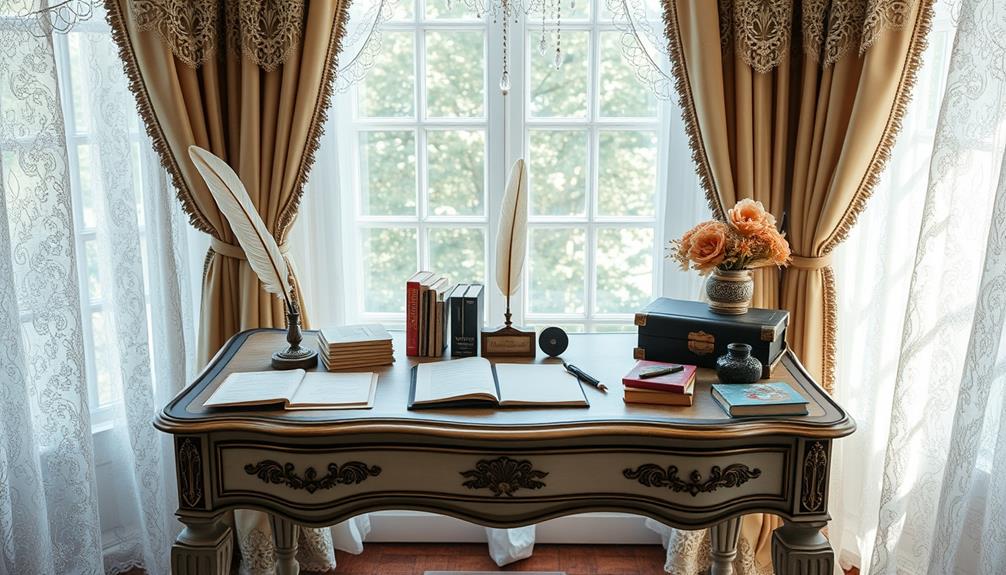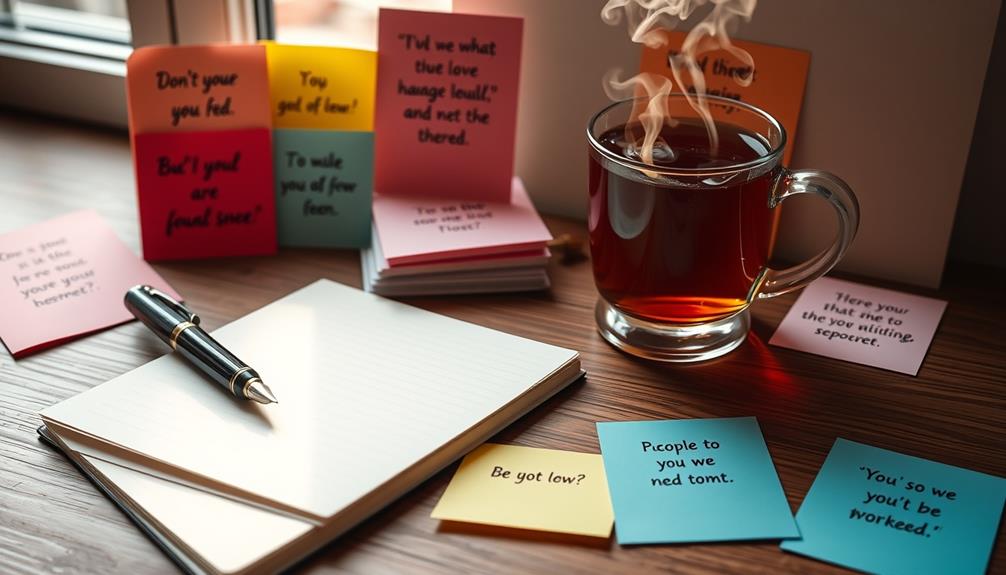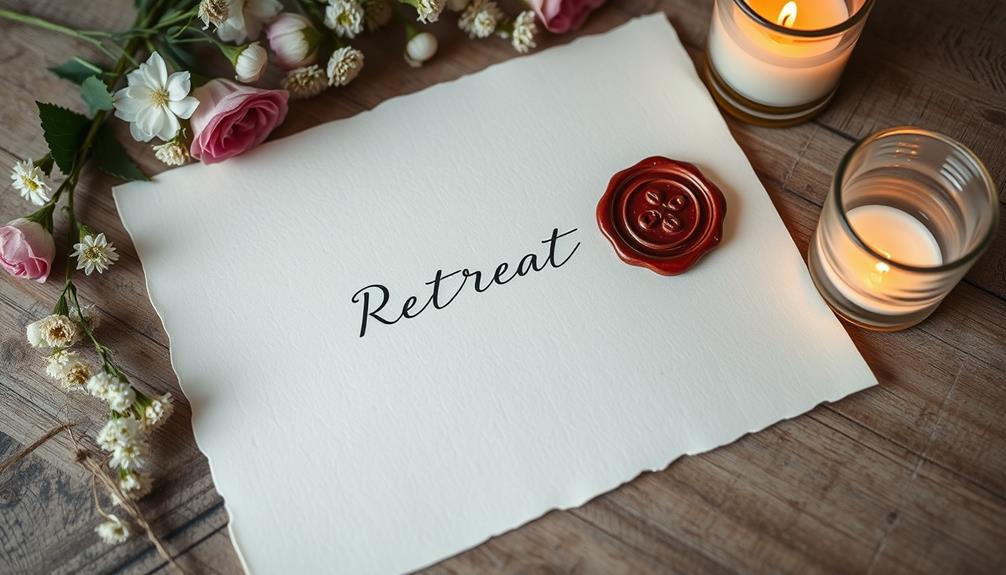To excel in writing retreat letters, focus on genuine warmth and connection. Begin with a heartfelt introduction, then reminisce about cherished memories to strengthen your relationship. Customize your language to suit the recipient’s preferences, ensuring that your message resonates with them. Use creative stories and vivid descriptions to evoke their emotions. Incorporate meaningful quotes that reflect shared experiences and emotions. Maintain a balance of clarity and emotional depth, avoiding overwhelming sentiments while providing support. Lastly, present your letter with care on high-quality paper with personal touches. There is so much more to discover in the realm of writing impactful letters that uplift and inspire! When composing a retreat letter, it is essential to take into account the recipient’s current situation and challenges. Offering words of encouragement and practical guidance can be extremely valuable. Additionally, adding some humor and light-heartedness can help boost their spirits. For more retreat planning recommendations and heartfelt letter inspiration, consider exploring books, blogs, and other literary sources that emphasize the importance of meaningful communication.
Key Takeaways
- Understand your audience's emotional state to tailor the tone and content of your letter for greater impact.
- Incorporate personal anecdotes and vivid imagery to create a relatable and engaging message.
- Use supportive phrases and cherished memories to reinforce the bond and express appreciation.
- Select meaningful quotes that encapsulate emotions and inspire reflection in the recipient.
- Present the letter on high-quality paper with a personal touch, such as handwritten notes and decorative elements.
Purpose and Significance

Retreat letters hold a unique purpose and significance in our lives, offering a powerful means of connection and support. When you write a retreat letter, you create a lifeline that uplifts and inspires the recipient, guiding them toward transformative experiences.
These letters serve as enduring sources of comfort, especially during tough times. You know that a well-crafted letter can evoke reflection and personal growth, reinforcing your feelings and intentions.
For the recipient, it often becomes a cherished keepsake, embodying your care and thoughtfulness. By sharing your emotions and insights, you help foster a deeper bond that can leave a lasting impact, proving that words truly have the power to heal and connect us in profound ways.
Know Your Audience

Understanding your audience is essential when crafting retreat letters. Knowing who you're writing to can make all the difference in how your message resonates.
Here are three key aspects to contemplate:
- Relationship Dynamics: Recognize your bond with the recipient—whether they're a friend, family member, or colleague—and tailor your language accordingly.
- Personal Preferences: Reflect on their interests, beliefs, and values. This helps you choose the right anecdotes and themes that will connect deeply.
- Emotional State: Assess what the recipient might be going through. Acknowledging their feelings allows you to craft a message that offers genuine support and encouragement.
Establishing Tone and Structure

When crafting a retreat letter, the tone and structure play essential roles in conveying your message effectively. You should choose words that resonate with warmth, encouragement, or empathy, ensuring they align with the recipient's personality.
Start with a warm opening that establishes a personal connection, followed by cherished memories that highlight your bond. Include supportive phrases that express appreciation and encouragement.
The structure should flow logically, guiding the reader through your thoughts while maintaining emotional depth.
Creative Language Choices

Crafting a retreat letter goes beyond just tone and structure; it hinges on the creative language choices you make. Your word selection can elevate your message and connect deeply with the recipient.
Here are three key elements to reflect upon:
- Personal Anecdotes: Share specific memories that resonate, making the letter feel uniquely yours.
- Vivid Imagery: Use descriptive language that paints a picture, engaging the reader's senses and emotions.
- Playful Doodles: Incorporate visual elements like doodles or different fonts to add personality and warmth.
The Power of Quotes

Quotes hold a unique power in retreat letters, as they can encapsulate profound emotions and thoughts in just a few words. They serve as touchstones, reminding both you and the recipient of shared beliefs and experiences.
When you choose a quote that resonates, it can evoke feelings of hope, strength, or love, enhancing your message's emotional depth. You can use quotes to bridge gaps, making complex emotions more understandable.
They're not just filler; they can inspire reflection and spark conversation. By incorporating meaningful quotes, you elevate your retreat letter, making it memorable and impactful.
Emotional Balance and Clarity

Emotional balance and clarity are essential in retreat letters, ensuring your heartfelt sentiments resonate without overwhelming the recipient. Striking this balance helps you connect meaningfully while maintaining focus.
As you navigate your thoughts, reflect on how philosophical exploration can enhance your understanding of personal choices. Here are three key points to reflect on:
- Be Genuine: Share your emotions authentically, but avoid excessive drama that might cloud your message.
- Stay Concise: Keep your thoughts clear and straightforward. This prevents misinterpretation and keeps the recipient engaged.
- Use Positive Language: Frame your words to uplift and inspire, fostering a sense of encouragement while remaining relatable.
Final Touches and Presentation

The final touches on your retreat letter can elevate its impact and leave a lasting impression. Consider using high-quality paper or stationery to enhance the overall presentation.
Handwriting your letter adds a personal touch that digital formats simply can't replicate. Don't forget to include a thoughtful closing, perhaps a heartfelt sign-off that resonates with your message.
If you're feeling creative, add doodles or small decorative elements that reflect the letter's theme. Finally, double-check for any typos or grammatical errors—clarity is key to ensuring your sentiments shine through.
When you present your letter in a nice envelope, it shows you care, making the recipient feel valued and cherished. These final touches can transform a simple letter into a treasured keepsake.
Frequently Asked Questions
How Long Should a Retreat Letter Typically Be?
A retreat letter should typically be concise yet meaningful, around one to two pages. You want to express your thoughts clearly while allowing enough space for emotion and reflection, creating a lasting impact.
What Common Mistakes Should I Avoid When Writing?
When writing, avoid being overly generic or formal. Don't neglect personal anecdotes, and steer clear of negativity. Guarantee clarity and emotion coexist; too much sentiment can confuse your message. Keep it genuine and heartfelt.
Can I Include Humor in My Letter?
Absolutely, you can include humor in your letter! It lightens the mood and builds connection. Just guarantee it aligns with the recipient's personality and the overall tone you want to convey. Keep it genuine!
What Is the Best Way to Address the Recipient?
Hey there, when addressing your recipient, think of it like sending a text. Use their name warmly, consider your relationship, and match your tone. A personal touch makes your message resonate and feel genuine.
Should I Handwrite or Type My Retreat Letter?
You should consider handwriting your retreat letter. It adds a personal touch, showing effort and care. Typed letters can feel impersonal, while handwritten notes convey warmth, making your message resonate more deeply with the recipient.
Conclusion
As you commence your letter-writing journey, remember that "a friend in need is a friend indeed." Each retreat letter you craft holds the potential to uplift and inspire, creating a lasting connection. By understanding your audience and embracing your unique voice, you'll transform simple words into cherished keepsakes. So, let your heart guide your pen, and watch as your letters become powerful bridges of solace and encouragement for those who need it most.









